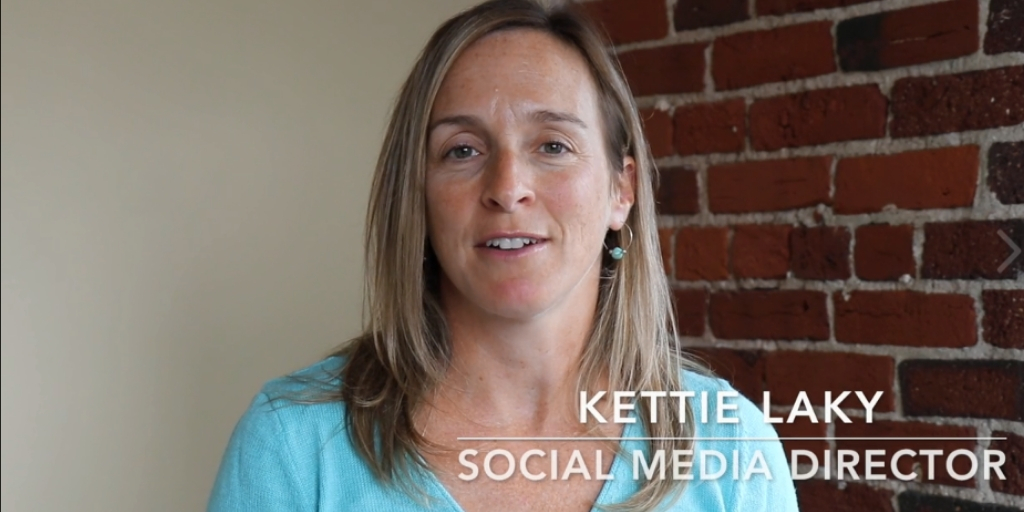
by Fronetics | Oct 8, 2018 | Blog, Content Marketing, Logistics, Marketing, Social Media, Strategy, Supply Chain
Social media’s ability to exponentially grow brand awareness and introduce your content to unseen audiences can’t always be measured in dollars.
One of the hardest parts about implementing a social media strategy is struggling to measure its success. While most B2B marketing professionals agree that a social media presence is crucial to any content marketing strategy, it can be hard to justify the investment when you can’t quantify the results.
“Social media is not just a spoke on the wheel of marketing. It’s becoming the way entire bicycles are built,” says Ryan Lilly, author.
This doesn’t mean that your business shouldn’t be diving — head first — into social media. With over 3.1 billion people using social media, businesses have to recognize the importance of social media as a part of a robust marketing strategy.
[bctt tweet=” With over 3.1 billion people using social media, businesses have to recognize the importance of social media as a part of a robust marketing strategy.” username=”Fronetics”]
Marketers need to start thinking about social media success in terms of potential, instead of immediate dollars.
Social media: the reach
One of the most valuable aspects of social media is the ability to engage with new audiences, all the time. That means you not only have access to a new customer base, but to their connections as well.
When your followers engage with your brand on social media, they also engage with their own personal network. This organic reach is one of the most beneficial aspects of social media — and it’s not easy to put a dollar amount on. The potential to nurture leads and ultimately impact sales are huge, but it won’t happen overnight.
Here’s Kettie Laky, Social Media Director at Fronetics, to share why you need to frame social media success in terms of potential, and not just dollars.
Video: Measure social media success in terms of potential, not just dollars.
It’s time we start thinking about social media success in this new way: in terms of potential and expanding value, rather than just immediate dollar amounts. How have you worked to measure the success of your social media strategy?
Related posts:


by Fronetics | Oct 3, 2018 | Blog, Content Marketing, Data/Analytics, Logistics, Marketing, Social Media, Supply Chain
Use these three steps to calculate your social media ROI and prove the value of your investment.
As supply chain and logistics businesses are finally recognizing the merits of content marketing, and more specifically social media platforms, many are looking into implementing a program at their companies. But it doesn’t take much research to realize what an enormous investment it is. And how difficult it can be to prove social media ROI.
We understand the time and money it takes to successfully implement and manage a social media strategy as a part of your content marketing plan. Many companies we talk to need help convincing management that it’s a worthwhile investment. To that we say, use data!
[bctt tweet=”We understand the time and money it takes to successfully implement and manage a social media strategy, as a part of your content marketing plan. Many companies we talk to need help convincing management that it’s a worthwhile investment.” username=”Fronetics”]
But what data should you use? How do you quantify certain benefits, like growth in brand awareness? And do you really have to keep track of all the hours you spend managing social media, crafting new tweets, etc.?
Here are three simple steps to start proving your social media ROI.
Infographic: 3 steps to prove social media ROI
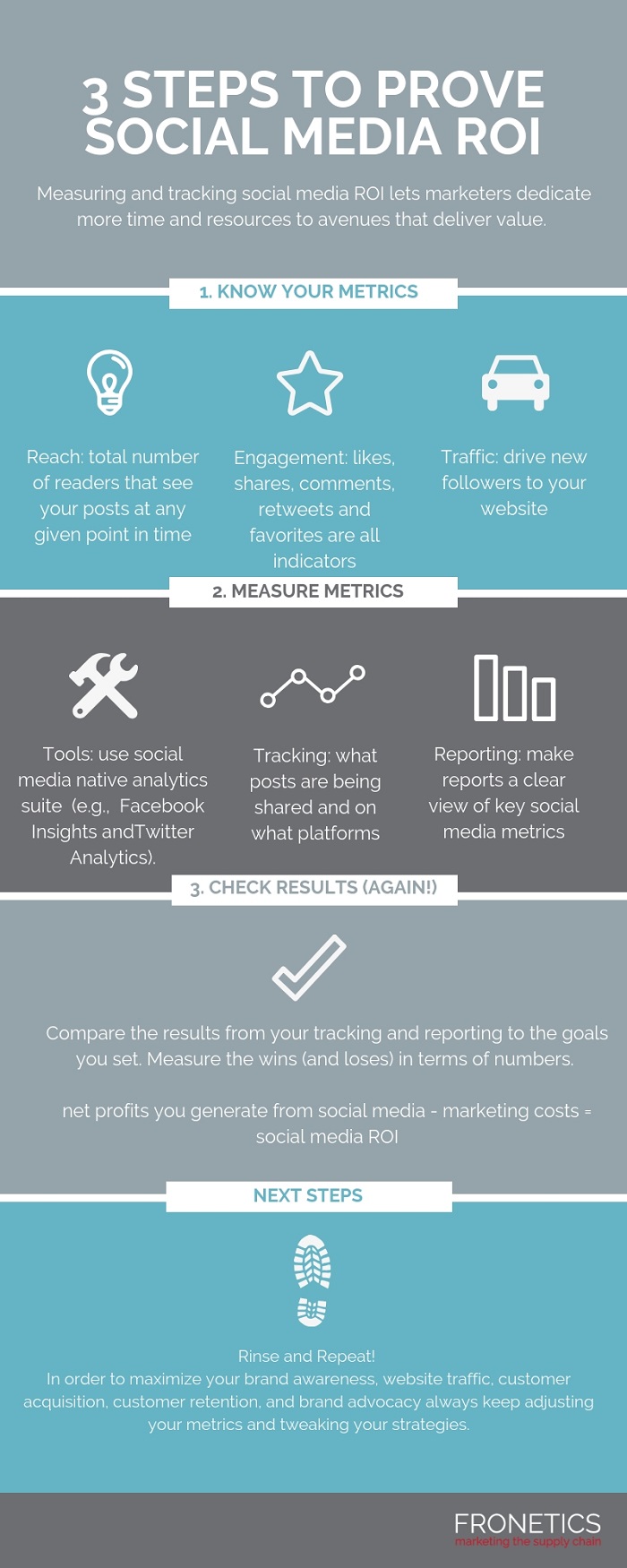
(Made with Canva)
Final thoughts
Once you’ve calculated ROI for your social media platforms, it’s time to think strategically about optimizing your content marketing resources in terms of allocation and timing. Having hard data helps you answer questions about which initiatives are most fruitful, what language engages your audience best, when your efforts are most likely to pay off.
Ultimately, this data-driven approach lets you continually adapt to the needs of your audience, ensuring an ongoing, robust ROI.
Have you had to prove your social media ROI? What strategies did you use?
Related posts:
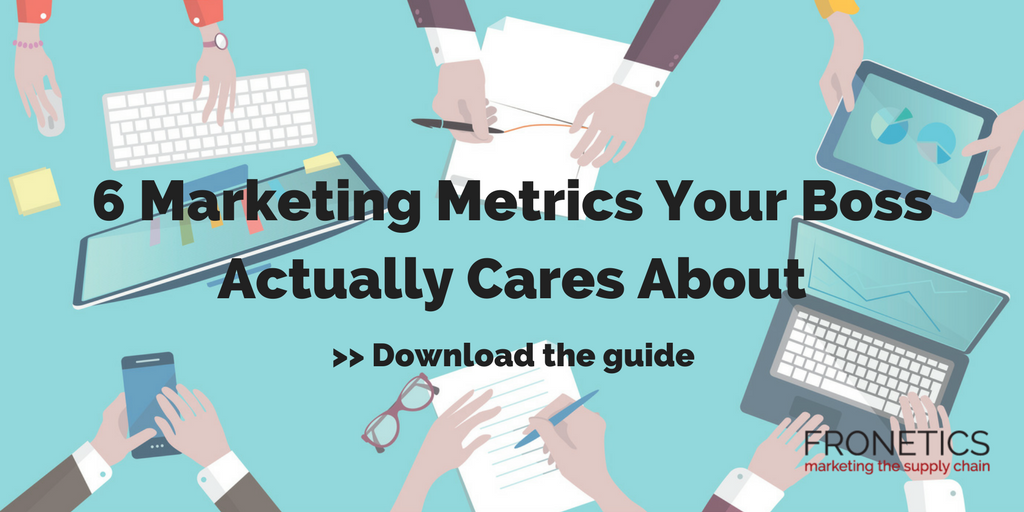

by Fronetics | Sep 20, 2018 | Blog, Content Marketing, Logistics, Marketing, Social Media, Supply Chain
Online searches, vendor websites, and peer recommendations are the top 3 resources for B2B buyers.
As a marketer, it’s not enough to just know about the B2B buyer’s process. Your success rides on your ability to understand how your buyers are getting their information — and, more specifically, where they’re getting the information they need to make a purchasing decision.
So where are they getting most of their information? I can tell you, it’s no longer from sales reps.
In our digital era, buyers are heading straight to the internet to gain valuable insight before making purchases. Thanks in large part to social media, mobile technologies, and the world wide web, buyers are becoming increasingly self-sufficient. In fact, 70% of the buyer’s journey is complete before a buyer even reaches out to sales. This means they have already spent a fair amount of time educating themselves with the enormous amount of information available to them on the internet.
[bctt tweet=”70% of the buyer’s journey is complete before a buyer even reaches out to sales. This means they have already spent a fair amount of time educating themselves with the enormous amount of information available to them on the internet.” username=”Fronetics”]
Is your content marketing meeting buyers where they are? Here are the three most important sources of information for B2B buyers.
Infographic: 3 top resources for B2B buyers
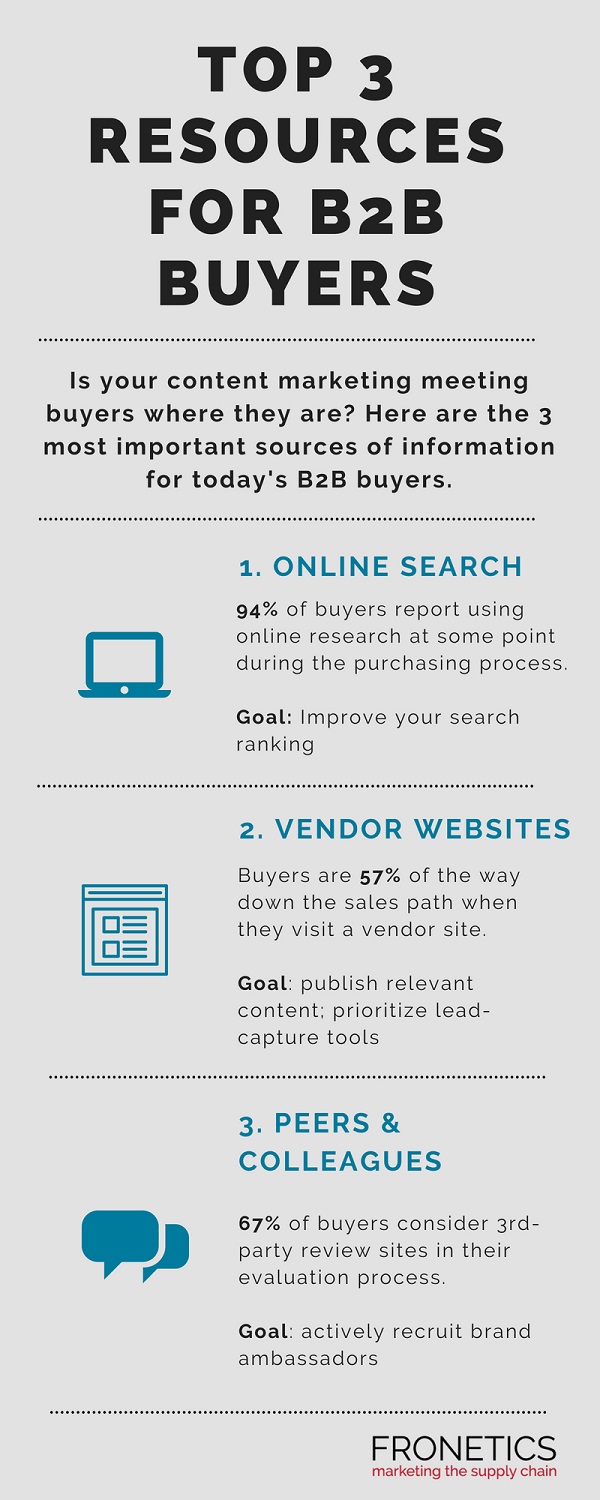
(Made with Canva)
Takeaway: Get in early
Listen, your prospects are forming their opinions about your business and your products based on what they find on the web, and early on.
This new reality may seem daunting, given how much of the purchase decision-making process occurs before you have the opportunity to engage with a potential client. But in reality, this changing climate offers serious opportunities for businesses to demonstrate their expertise, without turning buyers off with overt sales pitches.
To make the most of the potential purchaser’s experience with your business, content is key.
A robust content marketing program builds brand awareness, establishes trust and rapport with prospects, and generates traffic to your website. Thoughtfully generated and curated content catches the attention of buyers and keeps them interested in your business through the time of purchase.
With a well-thought-out, data-driven content marketing strategy, you’ll be ready to meet digital natives where they are.
Related posts:


by Fronetics | Sep 18, 2018 | Blog, Content Marketing, Current Events, Logistics, Marketing, Social Media, Strategy, Supply Chain
Ask yourself these five questions before you dive headfirst into an influencer marketing campaign to set you on the right path.
We’ve been writing a lot lately about influencer marketing and how it can work for the supply chain. These campaigns can be extremely effective — but getting the most bang for your buck requires a strategic approach from the outset.
Before you start an influencer marketing campaign, ask yourself these 5 questions.
5 questions to ask before starting an influencer marketing campaign
1. Why do I want to use influencers?
According to Natasha Lekwa, influencer marketing and social media editor at Snapchat, it’s important to “make sure you have a clear idea why you want to use influencers.” Answers might include boosting brand awareness, gaining followers, or increasing sales, to name a few. But each of these answers will lead you to a different strategy.
Being fully and deliberately aware of why you’re embarking on a campaign will help you set key performance indicators, determine your audience, and “envision what success will look like at the end of the campaign.” You’ll also be able to choose strategically the best platform to use, based on your content and target demographic.
2. Who are my influencers?
It may seem obvious, but you’d be surprised how often businesses dive into an influencer marketing campaign without having fully identified key influencers in their sector.
Lekwa suggest using hashtags to search Instagram for appropriate influencers and advises not just focusing on the obvious influencers in your industry. In fact, exploring influencers in other related industries can help expand your reach.
3. Who are my micro-influencers?
[bctt tweet=”Micro-influencers can give you a much higher ROI than big stars, and audience engagement tends to get higher as social niches get narrower.” username=”Fronetics”]
So you’ve identified your major influencers. Now you can start thinking about your “micro-influencers,” those with 10K to 100K followers. “Micro-influencers can give you a much higher ROI than big stars, and audience engagement tends to get higher as social niches get narrower,” Lekwa says. And since engagement is the name of the game when it comes to any kind of social media marketing, micro-influencers can be enormously valuable.
4. What are your terms?
Since influencers tend to be content creators at heart, they often have plenty of great ideas. But it’s important that your goals are transparent and aligned.
“It’s important to be on the same page,” says Lekwa. “Having a clear contract that spells out what each side will execute will help manage expectations for both your team and for the influencer.” In fact, Lekwa points out that influencers generally appreciate having guidelines and “the big conceptual themes of a campaign handed to them.”
5. What is my own value?
Approaching influencers can be intimidating. As Forbes writer Andrey Slivka points out, “As you might expect from people who get deluged with free stuff, influencers can be hard to impress.” This means you need to be clear and specific when you approach them about what you have to offer.
“Especially with micro-influencers, who are building their brands, what you offer doesn’t always have to be monetary,” Lekwa says. Often, brands can offer influencers exposure, the prestige of having their own brand associated with a larger business, or the resources to improve their content production.
Influencer marketing can be daunting at first, but it’s a powerful tool of the supply chain. If you lay the right foundation, an influencer marketing campaign has the potential to expand your brand’s reach exponentially.
Related posts:
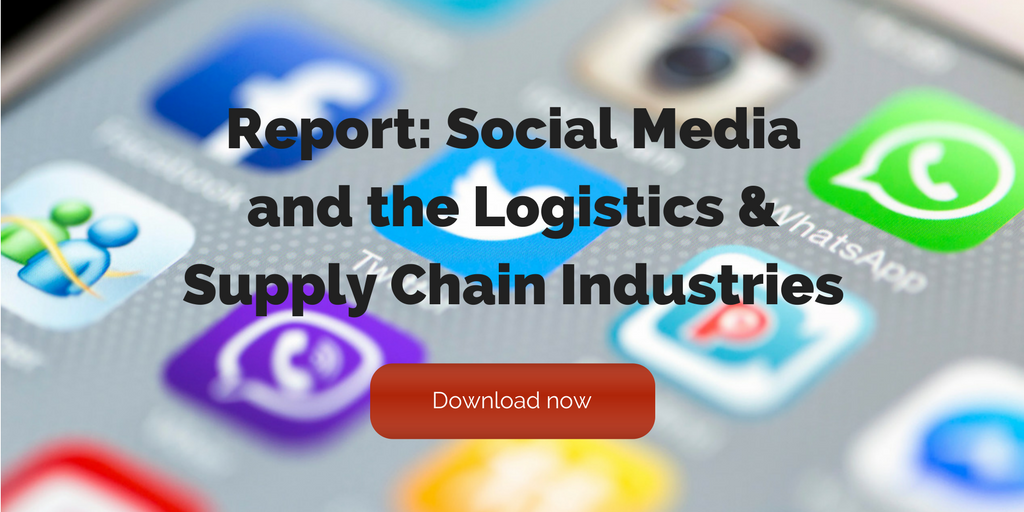

by Fronetics | Sep 11, 2018 | Blog, Content Marketing, Logistics, Marketing, Social Media, Strategy, Supply Chain
Daunted by the idea of proving social media ROI? These 3 steps will give you the structured framework you need to show the results of your efforts.
We all know social media is effective — but do we really know it?
Social Media Examiner’s 2018 Social Media Marketing Industry Report found that only 44% of marketers agree that they know how to measure social media ROI. That means two-thirds of you don’t know whether or not, or how much, your marketing efforts are paying off when it comes to the use of social media.
[bctt tweet=”Only 44% of marketers agree that they know how to measure social media ROI. That means two-thirds of you don’t know whether or not, or how much, your marketing efforts are paying off when it comes to the use of social media.” username=”Fronetics”]
Managing your business’ social media is no small task. It can be a time-consuming and laborious process, so you want to make sure you’re doing it right. That means having a systematic framework in place to prove social media ROI. These three steps will get you started.
3 steps to prove social media ROI
1) Set goals
It may seem obvious, but too many businesses approach social media marketing with vague goals or none at all. Deciding that you want to “grow your business” through social media is great — but it does little to set you up for success.
As you think about goals, keep the SMART principle in mind: Your objectives should be specific, measurable, achievable, realistic, and timed. So for example, instead of shooting to “generate more leads,” set a goal to “generate 10% more leads over 30 days.”
2) Track and measure
Once you’ve set your goals and identified your key metrics, it’s time to implement a system that will track and measure your metrics. At the very least, you should be tracking your metrics on a monthly basis.
We’ve created this monthly marketing reporting template just for supply chain and logistics businesses. It can help you measure social media ROI, as well as track your content marketing efforts, all in one place.
3) React
This is your endgame. While proving your ROI is a great outcome of tracking and measuring your metrics, the real object of your efforts should be reacting to what you discover. Look at your metrics in the context of your goals and objectives. Which efforts are moving you forward? What’s not working?
Trying to prove social media ROI is far from impossible when it’s supported by a solid framework. With a data-driven approach, you can prove ROI and use concrete tools to take steps to improve it.
Related posts:












